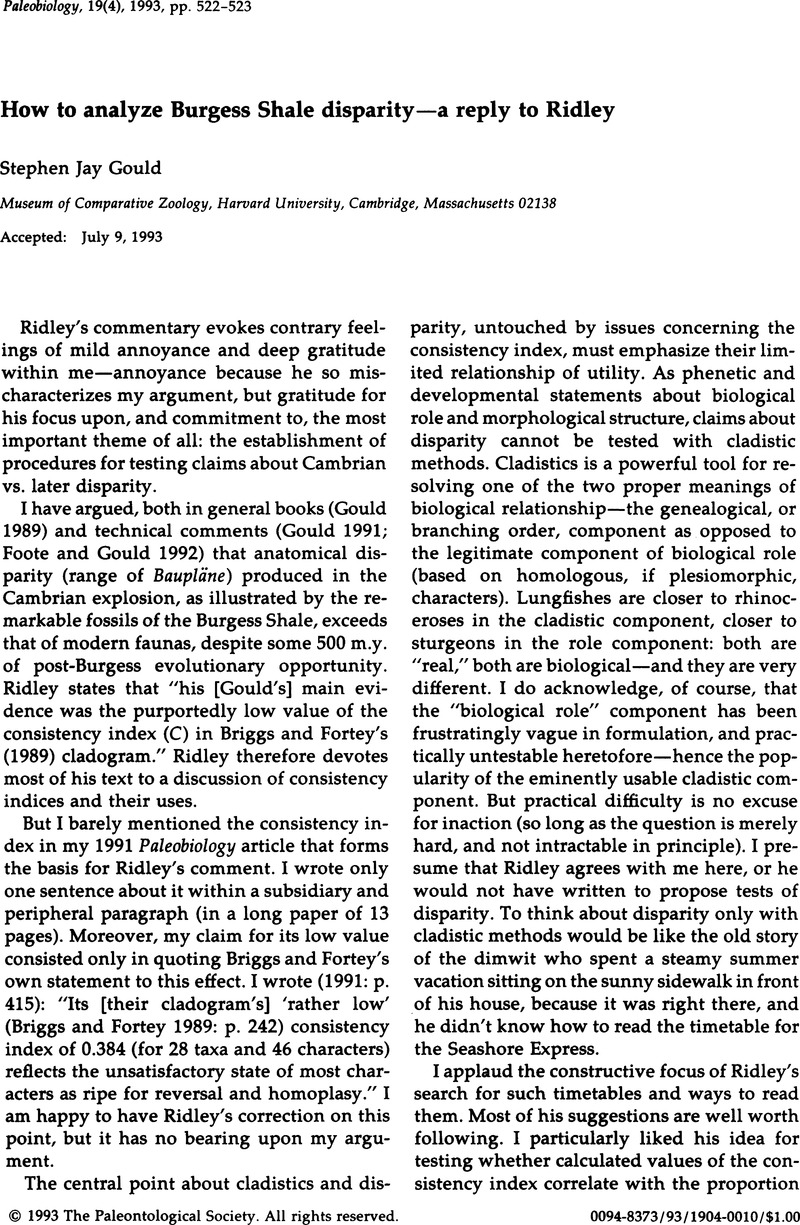Crossref Citations
This article has been cited by the following publications. This list is generated based on data provided by Crossref.
Sterelny, Kim
1995.
Understanding Life: Recent Work in Philosophy of Biology.
The British Journal for the Philosophy of Science,
Vol. 46,
Issue. 2,
p.
155.
Foote, Mike
1995.
Morphological diversification of Paleozoic crinoids.
Paleobiology,
Vol. 21,
Issue. 3,
p.
273.
McShea, Daniel W.
1996.
PERSPECTIVE METAZOAN COMPLEXITY AND EVOLUTION: IS THERE A TREND?.
Evolution,
Vol. 50,
Issue. 2,
p.
477.
Fortey, R.A.
Briggs, D.E.G.
and
WILLS, M.A.
1996.
The Cambrian evolutionary ‘explosion’: decoupling cladogenesis from morphological disparity.
Biological Journal of the Linnean Society,
Vol. 57,
Issue. 1,
p.
13.
Foote, Mike
1997.
The Evolution of Morphological Diversity.
Annual Review of Ecology and Systematics,
Vol. 28,
Issue. 1,
p.
129.
McShea, Daniel W.
1998.
POSSIBLE LARGEST-SCALE TRENDS IN ORGANISMAL EVOLUTION: Eight “Live Hypotheses”.
Annual Review of Ecology and Systematics,
Vol. 29,
Issue. 1,
p.
293.
Smith, Loren H.
1998.
Species level phenotypic variation in lower Paleozoic trilobites.
Paleobiology,
Vol. 24,
Issue. 1,
p.
17.
Ahouse, Jeremy C.
1998.
The Tragedy of a priori Selectionism: Dennett and Gould on Adaptationism.
Biology & Philosophy,
Vol. 13,
Issue. 3,
p.
359.
Hughes, Nigel C.
Chapman, Ralph E.
and
Adrain, Jonathan M.
1999.
The stability of thoracic segmentation in trilobites: a case study in developmental and ecological constraints.
Evolution & Development,
Vol. 1,
Issue. 1,
p.
24.
MIDDLETON, KEVIN M.
and
GATESY, STEPHEN M.
2000.
Theropod forelimb design and evolution.
Zoological Journal of the Linnean Society,
Vol. 128,
Issue. 2,
p.
149.
Wills, Matthew A.
2001.
How good is the fossil record of arthropods? An assessment using the stratigraphic congruence of cladograms.
Geological Journal,
Vol. 36,
Issue. 3-4,
p.
187.
Maclaurin, James
2003.
The Good, the Bad and the Impossible.
Biology & Philosophy,
Vol. 18,
Issue. 3,
p.
463.
Lofgren, Andrea Stockmeyer
Plotnick, Roy E.
and
Wagner, and Peter J.
2003.
Morphological diversity of Carboniferous arthropods and insights on disparity patterns through the Phanerozoic.
Paleobiology,
Vol. 29,
Issue. 3,
p.
349.
Lefebvre, Bertrand
2003.
Stephen J. Gould, les mitrates et les monstres.
Comptes Rendus Palevol,
Vol. 2,
Issue. 6-7,
p.
509.
Li, Meijun
Wang, Tieguan
Wang, Chunjiang
and
Zhang, Weibiao
2006.
Molecular composition and indigenity of organic matter in Late Neoproterozoic sedimentary rocks from the Yangtze region, South China.
Chinese Journal of Geochemistry,
Vol. 25,
Issue. 4,
p.
318.
PETERSON, KEVIN J.
SUMMONS, ROGER E.
and
DONOGHUE, PHILIP C. J.
2007.
MOLECULAR PALAEOBIOLOGY.
Palaeontology,
Vol. 50,
Issue. 4,
p.
775.
ERWIN, DOUGLAS H.
2007.
DISPARITY: MORPHOLOGICAL PATTERN AND DEVELOPMENTAL CONTEXT.
Palaeontology,
Vol. 50,
Issue. 1,
p.
57.
Baron, Christian
2011.
A Web of Controversies: Complexity in the Burgess Shale Debate.
Journal of the History of Biology,
Vol. 44,
Issue. 4,
p.
745.
Wills, M. A.
Gerber, S.
Ruta, M.
and
Hughes, M.
2012.
The disparity of priapulid, archaeopriapulid and palaeoscolecid worms in the light of new data.
Journal of Evolutionary Biology,
Vol. 25,
Issue. 10,
p.
2056.
McConwell, Alison K.
2019.
Contingency’s causality and structural diversity.
Biology & Philosophy,
Vol. 34,
Issue. 2,



